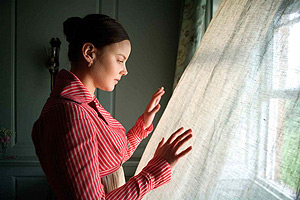
Was it a vision, or a waking dream?
Fled is that music:– Do I wake or sleep?
— John Keats, Ode to a Nightingale (1819)
1819 was the most prolific year of the English Romantic poet John Keats. Many of his well-known works were created then, two years before his untimely death from tuberculosis at age 25. His muse was Fanny Brawne, his 18 year-old neighbor, a fresh and self-assured young fashion designer whom he met a year earlier. Untrained in poesy or prose, Fanny Brawne had nothing in common with the brooding poet, but Fate, cruel or kind, instilled in them a burning passion for each other.
Unable to maintain a living financially, Keats was honorable to restrain his love for Fanny, knowing marriage would never be realized. Yet Fanny’s incessant devotion for him soon won him over. In a short time, she devoured all of Keats’ poetry, as well as other literary works through the ages. Their short-lived romance culminated in an engagement. But they were never married. Stricken by tuberculosis, Keats left for Italy in 1820 to seek better climate for his ailing health, knowing that would be their last farewell.
When I have fears that I may cease to be
Before my pen has glean’d my teeming brain…
Nominated for a Palme d’Or at the Cannes Film Festival this year, Jane Campion’s Bright Star is a beautiful tapestry weaving together the visual and the word. Based partly on Sir Andrew Motion’s biography on Keats, the film depicts the bittersweet romance between the poet and his muse, tragically short-lived yet ever burning bright.

Campion has created on screen the dazzling visuals of the master painters. There are numerous Vermeer moments in the interior shots, all done by the window with natural light seeping in as Fanny sews, makes her laces, reads love letters. Outdoor scenes are a natural cinemascape reminiscence of impressionist vision. Like the paintings of Monet and Seurat, hazy and dreamlike, they effectively convey the illusive union the young lovers achingly long for but is teasingly placed out of their reach.
Although never consummated, their passion for each other is no less ablaze. The film is a clear statement that love is not synonymous with nudity and sex on screen. Campion has depicted their passionate ardor with sensitivity and restraints. There are moments of utter quietness, for love needs no language. There are scenes adorned with melodious vocals and instrumentals, augmenting the yearning within. Campion is a master of cinematic effects.
The talented Ben Whishaw (Perfume: The Story of a Murderer, 2006) is aptly cast as Keats. Fanny Brawne is played by Abbie Cornish (Elizabeth: The Golden Age, 2007). Both are award-winning rising stars in their homeland of England and Australia. Bright Star could well be their breakout work in North America.

Paul Schneider (Lars and the Real Girl, 2007) is convincing as Keats’ friend Charles Brown, and what looks like Fanny’s love rival. A stark contrast in character with the poet, Brown offers much needed tension and conflicts. Fanny’s adorable little sister Toots (Edie Martin) gets some of the best lines. Her brother and chaperone Samuel is played by Thomas Sangster. But why Thomas Sangster? The talented young actor who has held his own in such films as Love Actually (2003), Nanny McPhee (2005), and The Last Legion (2007) playing against such calibre actors as Liam Neeson, Ben Kingsley, Colin Firth and Emma Thompson, is put in the background only, with less than half a dozen speaking lines. There’s definitely a miscast here. (Watch for his role as Paul McCartney in the upcoming John Lennon biopic Nowhere Boy.)
While the film is a beautiful testament of a star-crossed romance, compared to Campion’s previous works, I find it lacks the depth and complexity of The Piano (1993, Palme d’Or) and the intensity and riveting effect of The Portrait of a Lady (1996). I have no problem with the slow pacing of Bright Star, but I do wish to see more dramatic conflicts and deeper exploration of character. A thing of beauty should indeed bring us joy, or deep emotion, but for some reasons the visual beauty has not come across to me as affectively and engagingly as they are intended.
Nevertheless, as the only woman director to have won the Palme d’Or in the 62 years history of the Cannes Film Festival, and one of three women ever nominated for an Oscar in directing, Campion has much to offer. I’m excited to see that it looks like the trajectory of Bright Star is one that shoots for the Academy Awards comes next March.
~ ~ ~ Ripples
(Photo Sources: canada.com, ctv.ca)
***